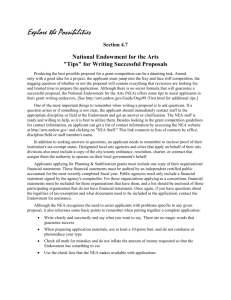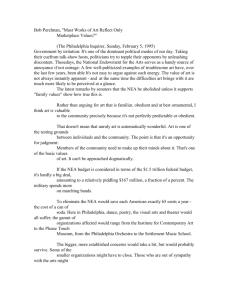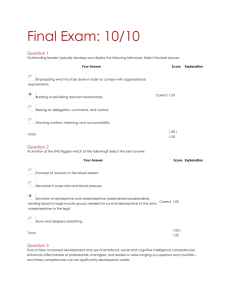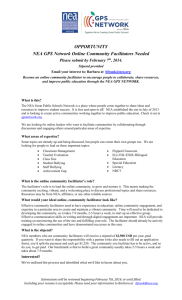Proposed NEA WG Charter
advertisement
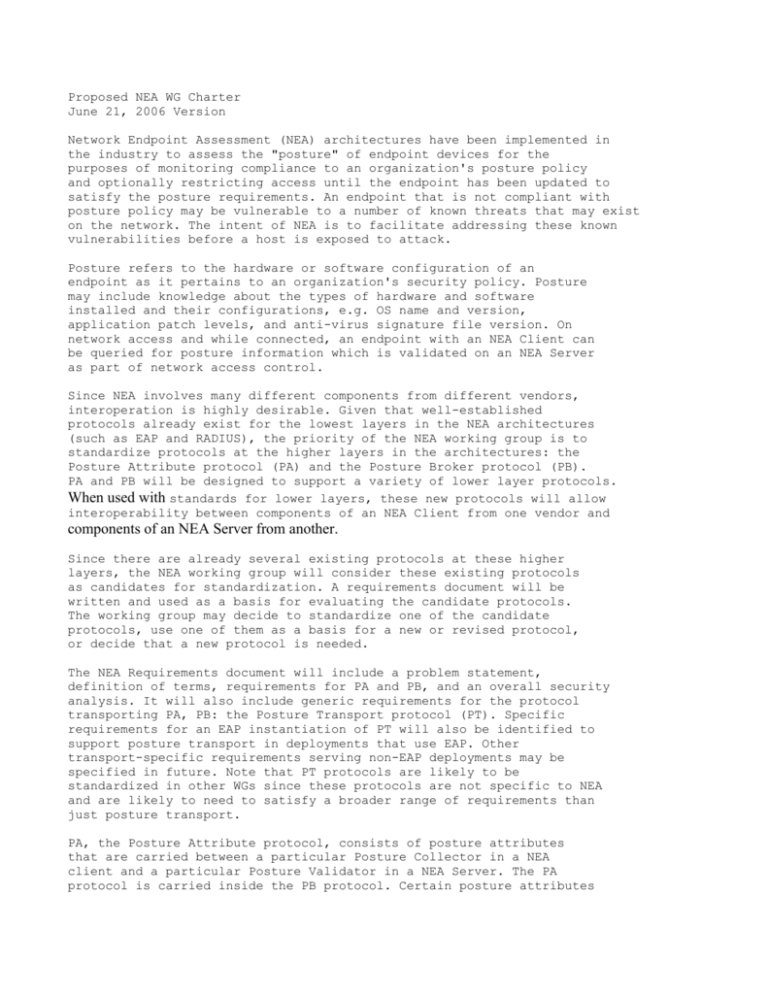
Proposed NEA WG Charter June 21, 2006 Version Network Endpoint Assessment (NEA) architectures have been implemented in the industry to assess the "posture" of endpoint devices for the purposes of monitoring compliance to an organization's posture policy and optionally restricting access until the endpoint has been updated to satisfy the posture requirements. An endpoint that is not compliant with posture policy may be vulnerable to a number of known threats that may exist on the network. The intent of NEA is to facilitate addressing these known vulnerabilities before a host is exposed to attack. Posture refers to the hardware or software configuration of an endpoint as it pertains to an organization's security policy. Posture may include knowledge about the types of hardware and software installed and their configurations, e.g. OS name and version, application patch levels, and anti-virus signature file version. On network access and while connected, an endpoint with an NEA Client can be queried for posture information which is validated on an NEA Server as part of network access control. Since NEA involves many different components from different vendors, interoperation is highly desirable. Given that well-established protocols already exist for the lowest layers in the NEA architectures (such as EAP and RADIUS), the priority of the NEA working group is to standardize protocols at the higher layers in the architectures: the Posture Attribute protocol (PA) and the Posture Broker protocol (PB). PA and PB will be designed to support a variety of lower layer protocols. When used with standards for lower layers, these new protocols will allow interoperability between components of an NEA Client from one vendor and components of an NEA Server from another. Since there are already several existing protocols at these higher layers, the NEA working group will consider these existing protocols as candidates for standardization. A requirements document will be written and used as a basis for evaluating the candidate protocols. The working group may decide to standardize one of the candidate protocols, use one of them as a basis for a new or revised protocol, or decide that a new protocol is needed. The NEA Requirements document will include a problem statement, definition of terms, requirements for PA and PB, and an overall security analysis. It will also include generic requirements for the protocol transporting PA, PB: the Posture Transport protocol (PT). Specific requirements for an EAP instantiation of PT will also be identified to support posture transport in deployments that use EAP. Other transport-specific requirements serving non-EAP deployments may be specified in future. Note that PT protocols are likely to be standardized in other WGs since these protocols are not specific to NEA and are likely to need to satisfy a broader range of requirements than just posture transport. PA, the Posture Attribute protocol, consists of posture attributes that are carried between a particular Posture Collector in a NEA client and a particular Posture Validator in a NEA Server. The PA protocol is carried inside the PB protocol. Certain posture attributes will be standardized to ensure interoperability but vendor-specific attributes will also be supported. PB, the Posture Broker protocol, aggregates posture attributes from one or more Posture Collectors in an NEA client and sends them to the NEA server for assessment by one or more Posture Validators. PT, the Posture Transport protocol, is a protocol (or stack of protocols) suitable for carrying the PB protocol at or after network connection. The NEA working group will not work on standardizing protocols other than PA and PB at this time. Further work in the NEA WG or in other WGs will be considered via the standard rechartering process after the completion of these milestones. One commonly discussed issue with NEA systems is how to handle compromised endpoints, whose reports of their own posture may not be accurate. Detecting or handling such endpoints is out of scope of the NEA WG. Work on PA will focus on attributes useful for assessing posture of those endpoints reporting accurate information. Milestones: June 2006: * Submit first version of NEA Requirements I-D July 2006: * Agree on charter and milestones at IETF 66 September 2006: * WG Last Call on NEA Requirements I-D October 2006: * Deadline for submission of candidate specs for PA and PB * Submit first version of NEA Evaluation I-D November 2006: * At IETF 67, review NEA Evaluation I-D December 2006: * WG Last Call on NEA Evaluation I-D January 2007: * Submit NEA Requirements I-D and Evaluation I-D to IESG as Info RFC * Submit first draft of PA and PB specs for review March 2007: * Discuss unresolved issues with PA and PB specs at IETF 68 * Agree on solutions to unresolved issues with PA and PB specs April 2007: * Submit revised draft of PA and PB specs June 2007 * WG Last Call on PA and PB specs July 2007 * Resolve outstanding Last Call comments on requirements I-D at IETF 69 August 2007: * Submit PA and PB specs to IESG for publication as Proposed

